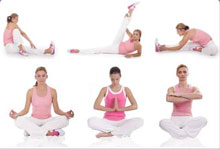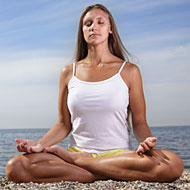Brahmari Pranayama (Humming Bee Breath)
Bhramari (Bee Breath) is a very effective pranayama (breathing exercise) for meditation. Performing this breathing exercise helps to induce a calming effect on the mind almost immediately. Practicing Bhramari pranayama benefits in reducing high blood pressure, fatigue, and mental stress. Also practicing this pranayama for ear, nose, mouth, and eye problems can have a positive effect.
Bhramari pranayama is also useful in curing paralysis and migraines. People of all ages can perform this breathing exercise including pregnant women. When performed during the period of pregnancy, it can help maintain and regulate the functioning of the endocrine system and provide trouble-free and easy child birth.
Bhramari pranayama is usually performed after completing Anulom vilom to obtain its full potential.
It's a kind of breathing exercise that develops powers of concentration memory and confidence. The extended, buzzing exhalation makes it very beneficial for pregnant women, in preparation for labor. Brahmari is sometimes known as humming breath and also renders a sweet clear voice to the practitioner. Hence it is highly recommended for singers.
Techniques of Brahmari
It is best done for 2-3 minutes.
How to Perform
- Begin in any comfortable seated pose such as Padmasana, Ardha Padmasana or Vajrasana.
- Keep your spine erect throughout the pose with your head straight and let your palms rest on your knees.
- Open your mouth slightly so that the jaw is relaxed.
- Raise your arms up with the elbows out and block your ears by placing the tips of your thumbs over the ears. Do not apply any pressure.
- Now place your index fingers above your eyebrows on your forehead.
- The two middle fingers should be placed over your closed eyes.
- The little fingers should be against the sides of your nostrils.
- Inhale deeply and fill the lungs with air.
- Exhale slowly through both nostrils.
- Keep your mouth closed.
- As you exhale, make a low humming sound.
- This humming sound should be continuous and as loud and clear as possible.
- The humming will cause vibrations that will be felt on the top of your head.
- As you practice this breathing technique, you should be aware of a sense of calm descending over you.
- Focus your awareness on your forehead and the sides of your head.
- To improve your meditation, mentally recite ‘OM.’
- This is considered one round.
- Gently release your fingers and open your eyes slowly.
- Relax in Gyana Mudra.
Best Time To Do Brahmari Pranayama
The best time to perform the bhramari pranayam is either in the morning or evening but always on an empty stomach.If you practice it in the morning it should be done after brushing and emptying out the bowels.If it is to be done in the evening, there should be a gap of at least 3-5 hours after lunch.
Duration
- This pranayam should be practiced eleven to twenty times a day. However, do not strain yourself or force the breath at any point. Gradually build up your strength and take a break whenever needed.
Benefits of Brahmari Pranayama
Pranayama cultivates a deep connection with the flow of life force (Prana) throughout your body. Further, Brahmari helps reduce stress and anxiety, expand joy and let you to relax both physically and mentally. Moreover, the inhalation clears and vibrates the throat. Other benefits of Brahmari include:
- Invigorates the thyroid gland increasing metabolism
- Balances hormonal secretion
- Triggers serotonin release, resulting in balanced moods
- Helps balance blood sugar
- Helps oxidizes fats in the body
- Very good for Alzheimer's disease
- Brahmari pranayama has helped cure migraine in the majority of sufferers.
- Practices like Brahmari pranayama act on the brain and produce quick and lasting relaxation.
- Brahmari pranayama is extremely beneficial to heart patients as it helps maintain overall working of the cardiovascular system.
- It helps in releasing heat from the body through perspiration and helps you feel rejuvenated.
- It is also very beneficial in regulating blood circulation within the body and lowering blood pressure.
- Bhramari breathing exercises should be performed regularly for controlling respiratory disorders, asthma and thyroid problems. People suffering from heart disease and diabetes can also benefit greatly from bhramari pranayam.
- Bhramari breathing exercises can be performed during pregnancy to regulate the endocrine system and maintain a healthy pregnancy.
- It is also said to facilitate easy child birth when practiced regularly through the pregnancy tenure.
- It improves the functioning of the nervous system.
- The humming vibrations of the Bhramari pranayam activate the pituitary gland which is one of the major glands in the body.
- Regular practice of this pranayam can help improve concentration and alertness.
- It helps awaken the Kundalini.
- When practiced during pregnancy, it is believed to help regulate hormones and ensure a trouble-free labor and delivery.
- This pranayam can help reduce migraines.
- It can help treat paralysis.
- It can cure insomnia.
Precautions
- The Bhramari pranayam should only be practiced under the supervision of a trained yoga instructor.
- Always perform this pranayam in seated position and never while lying down.
- If you have an ear infection, avoid this breathing exercise until the infection disappears.
- People with heart problems should not hold their breath when practicing this pranayam.
- Do not eat a heavy meal before practicing the Bhramari pranayam and keep a gap of at least a few hours between the last meal and this exercise, as the breathing puts pressure on the lungs and diaphragm and can affect the digestive process.
- Never force the breathing.
- If you feel dizzy at any point, stop the exercise and continue with your normal breathing.
Initially it is advisable to perform this pranayama under professional guidance before you start practicing on your own.
Read more articles from the Yoga Breathing (Pranayama) Category.
 Find Pose
Find Pose

